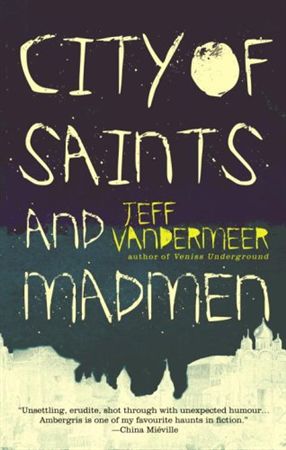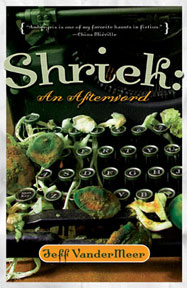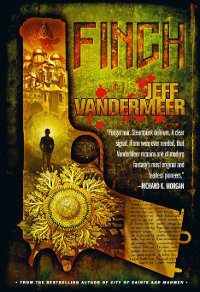Saints and Shrieks: Jeff VanderMeer’s Ambergris Fiction
 I don’t know what makes a novel great. Maybe every great book is great in its own way. I suspect, though, that a novel’s greatness resides most often either in its structure (not just its plot, but its balancing of themes and elements, its division into units like chapters, and its decision of what to describe and when) or its prose (its ability to make every word count, not only in depicting character and setting, not only in moving forward story, but in advancing the theme of the book, what it’s about, the idea that prompted the telling of the tale in the first place).
I don’t know what makes a novel great. Maybe every great book is great in its own way. I suspect, though, that a novel’s greatness resides most often either in its structure (not just its plot, but its balancing of themes and elements, its division into units like chapters, and its decision of what to describe and when) or its prose (its ability to make every word count, not only in depicting character and setting, not only in moving forward story, but in advancing the theme of the book, what it’s about, the idea that prompted the telling of the tale in the first place).
I suspect also that truly great novels fuse the two things, so that stylistic choices are an outgrowth of structure, while structural elements are visible in the voices the story uses. And all these things are always surprising the reader, even while making perfect sense.
Which brings me to Jeff VanderMeer, and his three novels of the fictional city of Ambergris: City of Saints and Madmen, Shriek: An Afterword, and Finch.
This is not a typical trilogy. The three books are very different from each other in both style and structure, although they do have some themes and characters in common. Chiefly, they have Ambergris in common.
Ambergris is a strange place, a baroque metropolis defined by wars between sprawling merchant houses, the orgiastic annual celebration of the Festival of the Freshwater Squid, and a mostly-subterranean nonhuman race called Grey Caps. The city changes over the course of the books — its technology shifts, its social structure is altered — but then the way we see the city changes as well.
VanderMeer shows his fictional city from a range of perspectives — not just through the eyes of different characters, but in the voices of different writers, through the concerns of different texts. The city is radically different from one story to the next; mysterious, and then comic, and then bitter, and then a mixture of all these things. That could easily cause the sense of place to become diffuse; instead, the opposite happens. You have the sense of a place with its own character, visible only through the obsessions of different people who live in it. Which means that it feels like a real city.
The first Ambergris book, City of Saints and Madmen, is a mosaic, a book made of many shorter wholes. Some of those shorter texts are relatively traditional short stories; others, particularly the writings which make up the “AppendiX”, are stranger. There’s a family history of a prominent Ambergris clan, a bibiography of books that don’t exist, a glossary of key terms — but these things aren’t like the glossaries and fictional histories you often find in fantasy books.
Partly that’s because of the tone in which they’re written. By turns exuberant and comedic, VanderMeer’s Ambergris here seems to be on the edge of turning into a joke on itself. But it never quite does; it has a coherence, an integrity, that keeps it credible.
More significantly, the extended playfulness of the texts have a serious purpose. They build up the world, linking the stories, and buttressing the peculiar relationship Ambergris has to what we think of as reality. Indeed, one of the main stories tells of us a writer in a lunatic asylum, who hallucinates the fictional city of Ambergris. Or so we think; at the end of the story, reality does a somersault underneath us, the true state of things is revealed, and what we thought we understood is shown to be the opposite of what is actually happening.
In general, that seems to me to be the key to City of Saints and Madmen. Reality is persistently questioned. The border between perception and delusion shifts. The novel creates an effect it couldn’t get at any other way. The fantasy is crucial; the structural play is necessary.
 Shriek is ostensibly the life story of fringe historian Duncan Shriek, as written by his sister, Janice. But something happened after she finished her book; she seems to have disappeared, and Duncan, thought dead, returned to annotate her text, taking issue with her statements here, expanding on hints there, and flatly contradicting whatever he’s of a mind to.
Shriek is ostensibly the life story of fringe historian Duncan Shriek, as written by his sister, Janice. But something happened after she finished her book; she seems to have disappeared, and Duncan, thought dead, returned to annotate her text, taking issue with her statements here, expanding on hints there, and flatly contradicting whatever he’s of a mind to.
The two squabbling voices make up the book, with its tale of intellectual adventure, intrigue, love, and war. The two characters are perfectly realised, complex and layered, and the way they look back at their own lives and others’ is perfectly measured.
The things that they say, and the way that they say them, and the way that their recollections clash, all work perfectly to give the reader a full sense of who they are, and of what matters to them. What Duncan argues with, and what he does not; what Janice does not say, and what she does — through these things they become living characters. And through them the book unfolds its ideas.
The structure of the book emphasises its own writing; Janice reflects on how she came to write the book, and what’s happening around her, while Duncan interpolates his notes into her text. So the book’s about writing, about language, and (for it is an “Afterword”) about the limits of language.
On the one hand, Duncan and Janice see so many things so differently, most notably Duncan’s mad love for his former student, Mary Sabon. But at the same time, their writing connects them; their language, the codes that two siblings create to communicate with each other.
 Finch is something else again: it’s a noir horror story. A hundred years after the previous book, Ambergris is ruled by the fungoid Grey Caps, who captured the city in a great Rising. Finch is a human, an uneasy collaborator pressed into service as a detective by the Grey Caps, who must solve a strange double murder.
Finch is something else again: it’s a noir horror story. A hundred years after the previous book, Ambergris is ruled by the fungoid Grey Caps, who captured the city in a great Rising. Finch is a human, an uneasy collaborator pressed into service as a detective by the Grey Caps, who must solve a strange double murder.
The novel deals with themes of identity and history; with what people choose to repress of themselves. Also, crucially, with transformation. Characters discard names, are warped by exposure to strange fungi — as Ambergris itself, under the Grey Caps, has become something different, something almost inexplicable. Something violent.
That violence is part and parcel of the noir form, and is used to good effect here; it seems to connect to a sense of physicality inherent in VanderMeer’s writing. Usually that means that the horrific or surreal aspects of VanderMeer’s writing are anchored in sensory detail, in taste and smell and touch. In Finch, it means that gunshots and punches connect, feel real, even when VanderMeer’s describing fungoid agents attacking a cell of rebel spies.
More broadly, the fantastic elements in Finch have the effect of heightening or intensifying the noir aspects. The two genres blend in an unusual but wholly natural way. Horror and fantasy hint at things beyond the human; noir shows us characters striving to learn the truth, even if they doubt the value of what they learn. Finch exists where those forms cross.
The book’s written in terse sentence fragments, which occasionally allow for moments of unexpected beauty. Some answers are forthcoming about Ambergris, and the sequence reaches a resonant ending, with much mystery explained but enough remaining to keep the books living in the reader’s mind.
VanderMeer’s written other books besides these three, notably his science-fiction novel Veniss Underground. He’s also well-known as an editor and anthologist; among other books, he and his wife Ann have edited two annual Best American Fantasy collections (which series has unforunately just been terminated), and a book of Steampunk fiction, with a second anthology forthcoming soon.
The VanderMeers also edited an anthology called The New Weird. ‘New Weird’ is a term that’s been used frequently over the last decade or so, often with reference to VanderMeer’s own fiction. Definitions tend to vary, but often seem to involve an attempt to reimagine classic weird fiction for a new century. Looking at VanderMeer’s Ambergris books might be useful here.
The novels are a kind of blend of H.P. Lovecraft or Clark Ashton Smith, and modernist writers like Nabokov or Pynchon. The weird irony of the pulp writers is there, the sense of horror that comes through confrontation with the utterly inhuman. But also present is the structural innovation of modernism (Shriek’s incorporation of marginalia into a text recalls Nabokov’s Pale Fire, a novel in the shape of a poem and its eccentric annotations).
And just as all these writers, in their different ways, paid careful attention to their prose, so does VanderMeer. His imagery has the thematic connectedness of the modernists, and the wild imaginative range of the fantasists. The unusual structures of the books give the fantastic substance new power; the fantastic material illuminates the themes of the books in a way that you couldn’t get with realistic fiction.
Superficially, it seems that the books get simpler as they go along. The multiple texts of City of Saints gives way to the arguing voices of Shriek which in turn gives way to the stripped-down third-person prose of Finch. But this, I think, is an illusion. You could just as easily say that the books get more sophisticated in the way that they contain each other, linking back to the previous books to pay off elements in unexpected ways.
Characters recur, gaining new depth. The city itself ages, and is shown in different ways. New tones are introduced, and news ways of thinking about what we’ve already learned.
In the end, I think the Ambergris novels make for a coherent whole, ‘New Weird’ or not. Precisely because they’re so different, each from another, they make for a constantly shifting reading experience, as our sense of what the books are doing, the ways in which their different aspects relate to each other, increases.
Stylistically, structurally, these books are a unity, for all their range of styles and tones. If they’re not great books, I have no idea what greatness is.
Matthew David Surridge is the author of “The Word of Azrael,” from Black Gate 14. His blog is Hochelaga Depicta.
This may be the decade’s best Fantasy Trilogy. The Ambergris books are utterly fantastic, especially CITY OF SAINTS AND MADMEN, which is the weirdest single book I’ve ever read.
Sigh. Yet one more series of titles I need to make time to read!
John
John: The books are only loosely connected through recurring charaters. It’s not a “trilogy” per se.
CITY OF SAINTS AND MADMEN stands on its own as a strange, musty relic from some bizarre world of sentient fungus and weird secrets. But it will definitely leave you wanting more from Vandermeer.
[…] 2017, Steph Swainston’s The Year of Our War, No Present Like Time, and The Modern World, and Jeff VanderMeer’s City of Saints and Madmen, Shriek, and […]